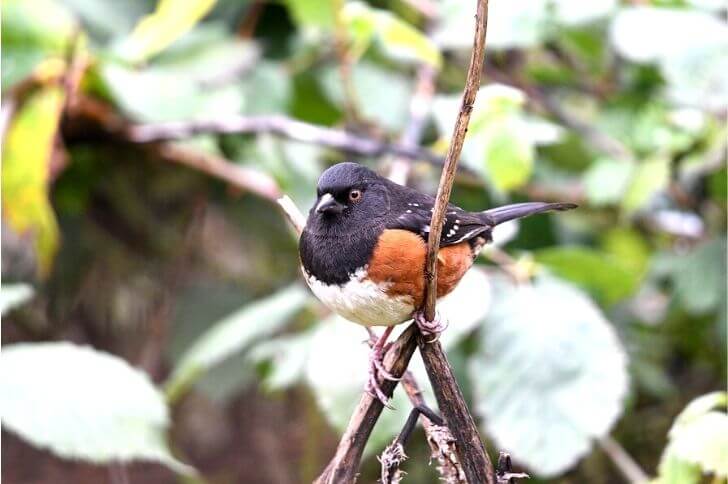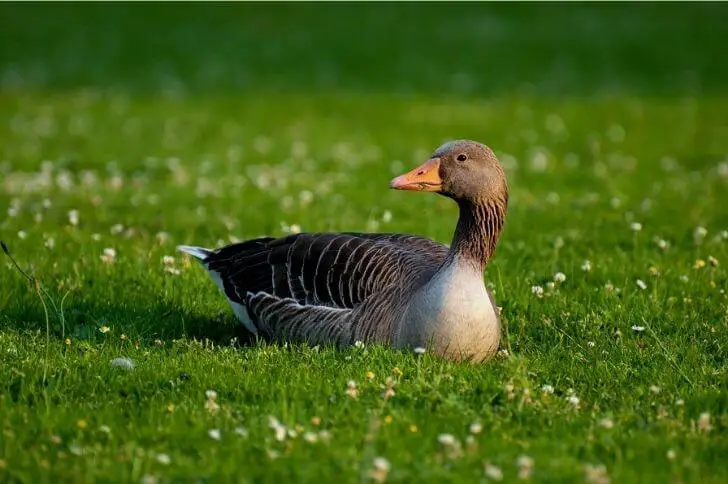Black birds with orange beaks are a curious sight. These birds are found in tropical and subtropical regions throughout the world, and their coloring is unique.
In the United States orange beak birds are mostly found in the states of Florida and Texas. We’ll also discuss birds from other parts of the world, their color patterns, breeding seasons and more. Scientists aren’t sure why this coloration occurs, but they think it may be a result of genetic differences or environmental factors.
List of Black Birds with Orange Beaks
1. Common blackbird

Size:
The common blackbird’s bill is described as yellow or orange in color. But first, let’s have a closer look at the size of this blackbird. How big is the common black bird? The size varies from 9 to 12 inches, making it smaller than red winged blackbirds. They weigh 3 – 5 oz.
Plumage:
Like male red winged blackbirds, male common blackbirds are mostly black with brownish wing tips. Notice the orange eye-ring and a slightly curved orange-yellow bill.
Being sexually dimorphic, females are different. The adult female common blackbird is brown overall with a paler breast and dull bill. Immature black birds are dark brown and slightly smaller streaked.
Habitat & facts
Common blackbirds are members of the thrush family. They are widespread in Europe, Asia, and Australia. These species breed in gardens, parks, and other open habitats.
They build a neat cup-shaped nest from mud, grasses, and other plant material. The common blackbird is omnivorous, eating insects, earthworms, berries, and other fruit.
Their calls range from alarming “pook-pook” to low warbles. Both parents are active during the breeding season. Females incubate for two weeks and flegling takes place after two weeks.
2. Grey-winged blackbird
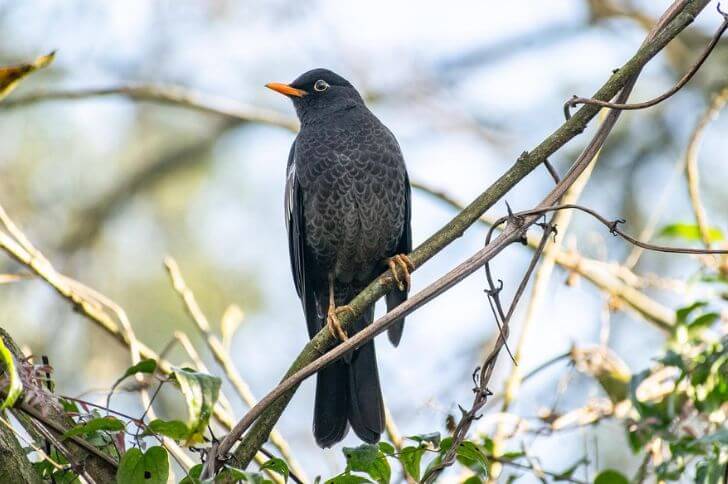
Size:
The grey-winged blackbird is a member of the blackbird family. It is a medium-sized bird. The adult male measures between 9 – 11 inches, same size and weight as the common blackbird.
Plumage:
With a long tail and an orange bill, the male has a black body and grey wings. The female is mostly brown with an orange beak.
Habitat & facts:
The grey-winged blackbird breeds in open areas across Southeast Asia. It builds a nest in a tree or bush, and lays four to six eggs.Eggs are blue or greenish-blue, with brown spots. This large black bird with orange beak eats insects and other small animals. It forages on the ground, in fields and marshes, or in trees.
3. Abyssinian scimitarbill
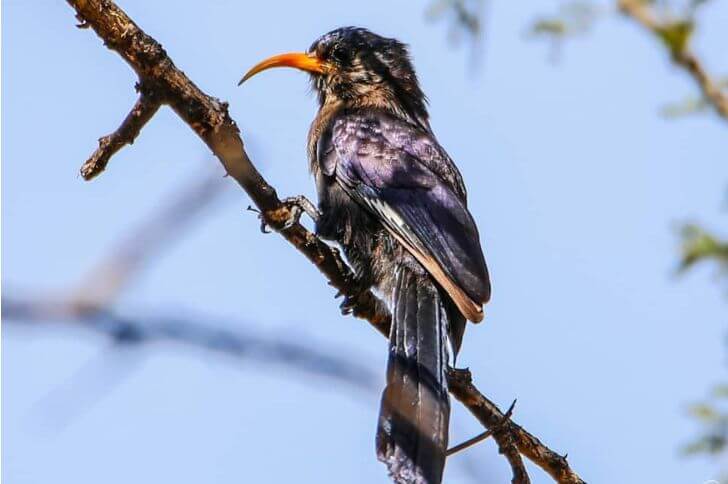
Sources: bird_of_ethiopia
Size:
Measuring 8 – 10 inches, the Abyssinian scimitarbill is a unique bird found in Eastern Africa. This medium-size bird with orange beak weighs about 1 oz.
Plumage:
How can I identify the scimitarbill bird? This all black bird is easy to identify. Both sexes share the same color pattern. Adults are all black with a long curved orange beak.
Habitat & facts
The orange beak is used for catching insects. It is also known to eat seeds and fruit.The Abyssinian scimitarbill can be found in many different habitats, including forests, grasslands, and scrublands.
4. American oystercatcher
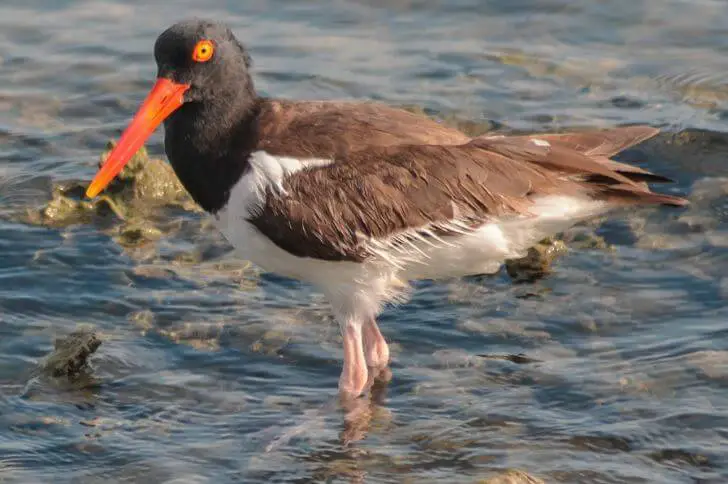
Size:
Looking for a resident breeder in the United States? With a population of over 43,000 birds, the American oystercatcher is an easy-to-spot bird in Florida. How big is the American oystercatcher? Adult males measure between 15 – 17 inches. Adult females are also the same size and weigh about 20 oz.
Plumage:
These birds do not exhibit sexual dimorphism. Both sexes are black and white with orange beaks. Juveniles spot a black-tipped orange bill and are duller in color.
Habitat & facts:
The American oystercatcher is a wading bird that inhabits estuaries, tidal flats, and beaches along the Atlantic and Gulf coasts of North America. What do oystercatcher birds eat? This Florida orange beak bird feeds primarily on shellfish, such as oysters, mussels, and clams.
How does an oystercatcher feed? They use their strong bills to pry open shells before extracting the meat with their sharp beaks. American oystercatchers are monogamous birds and pairs typically remain together for many years.
Where do American oystercatchers breed? Nests are built in protected areas near the water’s edge where two to four eggs are laid. Both parents share the responsibility of incubating the eggs and caring for the young.
5. Toco toucan

Size:
Toco toucans are the most popular birds in the toucan family. Also known as the giant toucan, this bird is about 21 – 26 inches from head to its tail feathers and has a wingspan of up to 40 inches. Adult males are slightly larger than females.
Plumage:
Toco toucans are mostly black with a white rump and throat. Each bird spots a large and heavy 7.5-inch orange bill. Note the orange skin that surrounds the dark eyes. Immature birds have shorter bills.
Habitat & facts:
The Toco toucan is a bird found in parts of South America. These birds typically live in rainforests and feed on fruit mostly oranges and figs but will also eat insects and eggs.
While they are not considered to be endangered, their populations have been declining in recent years due to deforestation and hunting. Toco toucans are popular pets due to their colorful plumage, but they require a lot of care and can be quite noisy.
You can easily spot them in flocks but they prefer to feed alone. Toco toucans can be quite noisy, producing snoring and grunting sounds.
6. Atlantic Puffin

Size:
Puffins are birds that are found in the colder climates of the world. The Atlantic puffin is a large black bird with orange beak that is easy to spot because of its size and distinctive features. Adult birds are up to 11 inches long and boast a 21-inch wingspan. They weigh up to 20 oz.
Plumage:
This black and white seabird is known for their colorful orange beaks and webbed feet. The bill has white -grayish grooves that increase as the bird ages. Their bodies feature black upperparts and white below. Notice the orange on cheeks and eyes.
Habitat & facts
Like other northern birds of the sea, this bird breeds on islands in burrows. Atlantic puffins spend a huge amount of their time in water. This black and white bird’s diet consists mainly of fish, but they will also eat crustaceans and other marine invertebrates.
Puffins are a threatened species due to climate change and human interference. There are efforts underway to protect these birds, and hopefully they will continue to thrive in the future. These birds with orange beaks and black bodies are unique and fascinating birds, and they are definitely worth getting to know better!
7. African skimmer
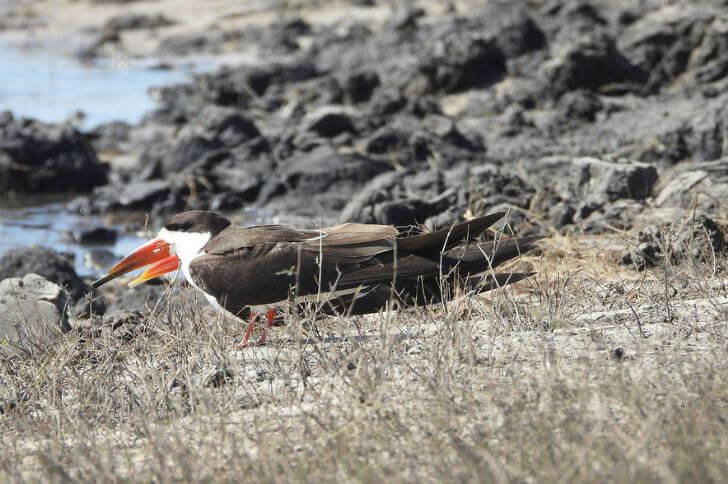
Size:
How big is the African skimmer? Most skimmer birds average 15 inches and are easy to spot. They weigh about 0.3 lbs and are known for their large wings that measure about 41 inches (106 cm)
Plumage:
African skimmer birds have very distinctive features that make them easy to identify. During your next bird watching trip in Tanzania, where they are commonly found, look out for slender long birds with a black back, long wings, white below and a long scissor-like orange beak. Their feet are also orange.
Habitat & facts
The African skimmer habitat ranges from coastal mudflats to sandbars. What do African skimmers eat? These birds feed by skimming the surface of the water for small fish and crustaceans. They are known to migrate to different parts of Africa during rainy and dry seasons.
8. Dusky lory

Size:
If you’re looking for a small, vibrantly colored bird to add to your collection, the dusky lory may be just what you’re seeking. Dusky lorikeets are 10 – 12-inch birds that stand at about 12 inches. They boast of 27 – 32 years lifespan.
Plumage:
Dusky lorikeets are not all-black. Depending on their preferred habitat, their color patterns range from yellow-black to black-reddish. But all sexes have one thing in common; short orange beaks.
Habitat:
This little bird is found in the forests of New Guinea and nearby islands, and is relatively common. They are very active birds, and love to play and chatter with their mates.
Dusky lories make good pets and can be taught to say simple words. They require a lot of attention, however, and need to be handled regularly to stay tame. They can be aggressive towards other birds, so it’s best not to keep them with other species.
What does dusky lory eat? The diet of dusky lorikeets mostly consists of fruits and pollen. If you have one under your care, ensure to feed it with kiwis and grapes.
How long do dusky lorikeets live? Up to 32 years under proper care.
9. Indian blackbird
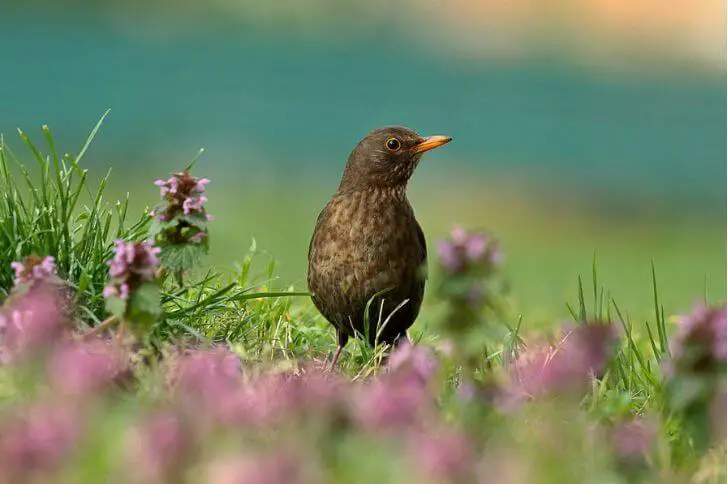
Size:
Indian blackbirds or the Turdus simillimus are found in India and parts of Southeast Asia. Adults are about 7 – 8 inches long from head to tail.
Plumage:
Indian blackbirds are pretty similar to the common blackbirds of Australia. They are mostly black with orange beak and eye-ring. Their feet are also yellow-orange.
Habitat & facts:
It is a member of the thrush family, Turdidae. They favor forests and woodlands, as well as gardens and parks. These orange beak birds with black bodies feed on insects, worms, berries, and seeds. The song of the Indian blackbird is a series of deep “chuk” sounds.
How long do Indian blackbirds live? Life expectancy of Indian blackbirds is about 2 – 3 years, depending on a number of factors including habitat loss.
10. Crested auklet
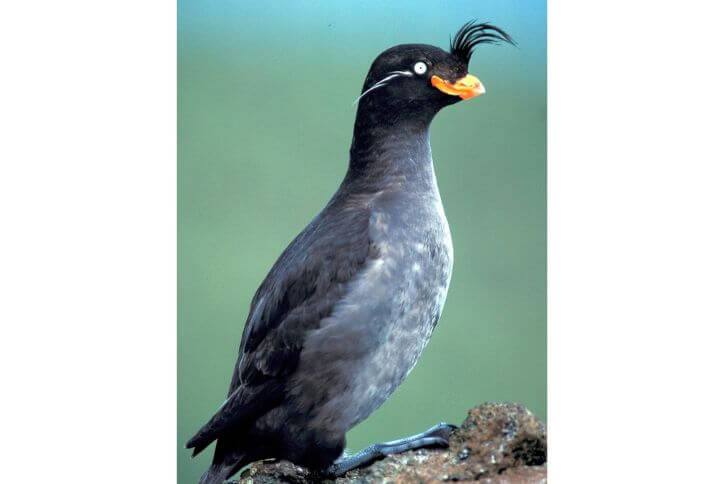
Size:
Dark and gregarious, the crested auklet is a 7 – 11-inch bird that is an excellent swimmer. They boast of a 13 – 20-inch wingspan and can weigh up to 12 oz.
Plumage:
I like it when I can spot a bird easily during one of my bird watching trips and the crested auklet has distinctive features that you can easily spot whether you are using your binoculars or not.
It features glossy black plumage with black-grayish feet. Bill is orange colored and short. Note their stunning pale eyes and a loose crest.
Habitat & facts:
Crested auklets are seabirds found in the North Pacific. They prefer staying in huge flocks. Their breeding habitat includes sea cliffs and boulder fields. This bird species builds nests close to each other with females laying one egg per season.
What does crested auklet eat? Mostly small crustaceans and a small number of fish.
11. Black laughingthrush
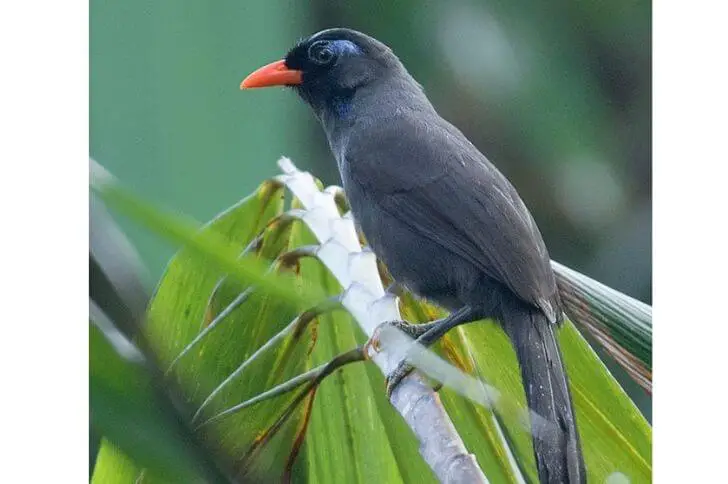
Size:
Another black bird with orange beak from Asia is the black laughingthrush. It’s a medium-sized bird, measuring between 9 – 12 inches and weighing up to 4 oz.
Plumage:
Honestly nothing stands out about their color pattern. Black laughingthrushes are dull and not easy to spot in dense vegetation. The only distinctive feature that you’ll spot is the orange bill.
Habitat & facts:
This passerine bird is a resident breeder in the Himalayas and parts of Southeast Asia. It is a member of the Timaliidae family and is closely related to the white-throated laughingthrush. It has a loud, ringing call that can be heard for some distance.
This bird with an orange beak feeds on insects, spiders and fruit. The male builds a cup-shaped nest out of grasses and mosses, which he lines with feathers. Female black laughingthrush lay two or three eggs.
13. Orange-billed sparrow

Source: jeorgebedoyabirder
Size:
Orange-billed sparrows are small passerine birds that are the same size as house sparrows; 5 – 7.2 inches long. Most adults weigh about 1.2 – 1.4 oz.
Plumage:
Unlike the other birds on our list, orange-billed sparrows are not entirely black. They feature an olive-black back, black head and breast, and paler underneath. The bright orange bill on both sexes is hard to miss.
Habitat & Plumage:
Orange-billed sparrows are found in moist lowland forests in Central America. This species is closely related to the white-throated sparrow.
14. Black oropendola
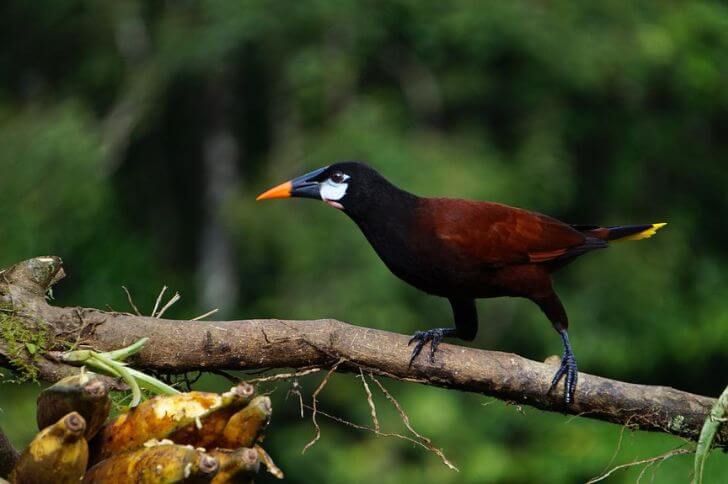
Size:
The black oropendola or the Psarocolius guatimozinus is an unmistakable bird found in Central America and parts of South America. They are typically around 18 inches long and have a wingspan of around 30 inches. Females are smaller, about 15 inches in length.
Plumage:
Black oropendolas are mostly black with chestnut wings, bright yellow tails and blue cheeks. The bill has an orange base and tip while the mid section is black.
Habitat & facts:
They are sociable and live in colonies of around 20-30 birds, and build large hanging nests made of vines and twigs. These nests can be up to 6 feet long! Black oropendolas are very vocal birds, and can often be heard making loud, screeching calls. They eat insects and fruit.
Females frequently copulate from February to June.
15. Black-and-gold cotinga
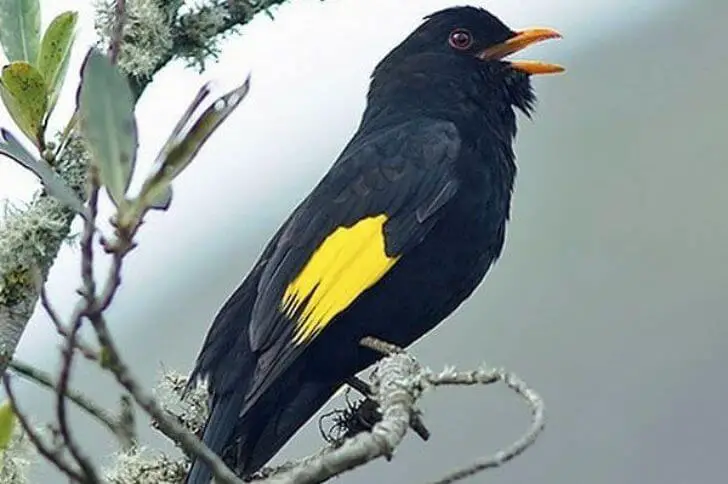
Size:
In the previous list of black bird with yellow wings, we took a look at the black-and-gold cotinga. We’ll also add it to this list because of its orange colored bill. It measures about 10 inches and its scientific name is Lipaugus ater.
Plumage:
Black-and-gold cotingas are sexually dimorphic. The adult male has striking plumage, with its all black body, yellow on wings and orange beak. Females and juveniles are less colorful, being mainly olive-green.
Habitat & facts:
This species is usually seen singly or in pairs, foraging for fruit or insects in the trees. It is fairly tame and can often be seen perched near human habitation. The black-and-gold cotinga is sometimes kept as a pet.
16. Tufted puffin

Size:
Another puffin bird that graces our list is the tufted puffin. How big are tufted puffins? Around 14 inches in length and males are larger than females.
Plumage:
How to identify a tufted puffin? Like other puffin birds, tufted puffins are all-black with a white face and a thick orange bill. They also have orange webbed feet and both sexes spot yellowish head plumes.
Habitat & facts:
Where are tufted puffins found? They are North Pacific seabirds ranging from Southern Alaska to the Northern channel islands.
What do tufted puffins do? They are excellent swimmers and are known to dive and catch up to 20 small fish on their beaks. They feed mainly on small fish, but will also eat squid, crustaceans, and marine worms.
Tufted puffins nest in colonies on offshore islands and use their bills to dig burrows in which to lay their eggs. The chicks are precocial and can leave the nest shortly after hatching.
They are able to swim and dive soon after birth and will accompany their parents to sea where they will learn to catch fish. Tufted puffin’s lifespan is about 20 years. This bird with a orange beak is a must see for any bird watching enthusiast.
17. Crested Caracara

Size:
Are there large black birds with orange beaks? The crested caracara is a great example. Measuring up to 26 inches and weighing up to 3.5 lb, the crested caracara is a large bird with orange beak that is found in Texas.
Plumage:
This hawk-like bird is easily recognizable because of its dark body, dark crest, white throat and the orange-yellow bill. Immature birds are brownish.
Habitat & facts:
The Crested Caracara is a raptor that is both diurnal and scavenger, feeding on carrion as well as live prey. These birds of prey can be found in a variety of habitats, including open fields, deserts, and tropical rainforests. It typically nests in trees or on cliffs.
This orange and black bird is considered to be near threatened due to habitat loss and hunting. The Crested Caracara is popular with hunters due to its size and scavenging habits, making it vulnerable to poaching. In addition, the bird’s large range makes it susceptible to habitat destruction from development or climate change.
18. Rhinoceros Hornbill
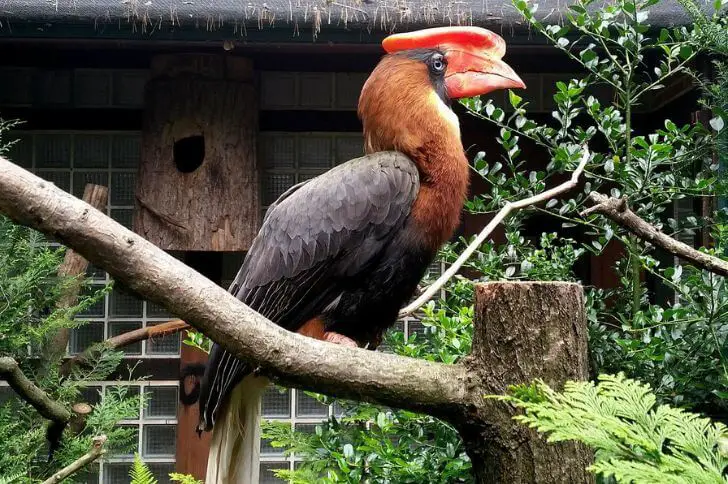
Size:
Hornbills are pretty hard to miss. The rhinoceros hornbill is a large bird, up to 35 inches long, and can weigh around 6 lbs.
Plumage:
Rhinoceros hornbills are one of largest hornbills in the world, making them instantly identifiable. Adults have large orange casques on their heads that curve upward. This distinctive feature is used to attract mates and intimidate rivals. The bill is long and thick.
Their bodies are black with a white rump and black and white tail.
Habitat & facts:
Rhinoceros hornbills are monogamous birds, and both parents help care for the young. The female lays two eggs in a tree hole, and the male brings food to her and the chicks. The chicks stay in the nest for sometime.
Hi, my name is Steve. My friend and I started the spanishbirdguides.com to share our passion with other like-minded people. So, if bird watching is your thing, you’ll love this blog. I’ll share what I’ve learnt about both local birds and those found in other parts of the world. Also, I’d love to hear your experiences.
